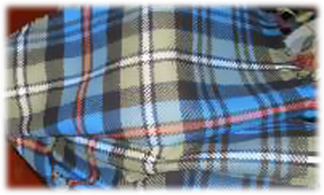
Mackenzie 78th Highlanders – Re-created specially for the Millennium Gathering
Earliest Known Date: 1778
Earliest sample certified at the Highland Society of London:- Signed by Mrs Mackenzie of Seaforth, 1816
Earliest Recorded Source: Wilson’s pattern book, 1819
Status: Public Register of All Arms and Bearings, 1949
Type: Symmetrical
The Mackenzie Tartan is the regimental tartan of the Seaforth Highlanders, which were raised by Mackenzie, Earl of Seaforth in 1778. Wilson’s 1819 pattern book records various widths and weights of cloth suitable for different ranks in the regiment. There is a certified sample in the Collection of the Highland Society of London, signed by Mrs Mackenzie of Seaforth, 1816.
The Mackenzie tartan as we know it today is a military tartan and was developed by the Mackenzie Lord MacLeod’s 73rd (and continued later by the Seaforth Highlanders), which was taken from the an early version of the Black Watch (developed about 1729) and had Black, White and Red lines added. In fact most clan tartans today were developed since the military Highland Independent Companies introduced the idea of using the pattern for identity between 1725 and 1739. With exceptions there are very few examples of tartan patterns being used for clan identity prior to 1700, moreover it was the cap badge, usually a plant or ribbon, which was used for identity. However there is evidence that regional tartans existed. This would explain why different tartans were seen being worn by the same clan at the battle of Culloden.
Planning to have a kilt made? Members of the Clan MacKenzie Society of Canada may purchase high quality Mackenzie Modern tartan for their project. Please contact alan@mkz.com
Authenticated by world renowned tartan & weaving authority, James Scarlett, a fresh Mackenzie tartan has been discovered, reminiscent of the current “Ancient” colouring but with subtle differences. The material has been woven to match the original piece dated from the 1820s. The white stripe originally thought to have been of silk is woven with a partly cashmere interface.
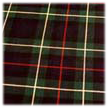
MacKenzie – Modern
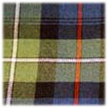
Mackenzie – Muted Green
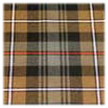
Mackenzie – Muted Brown
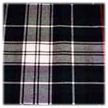
Dress MacKenzie – Modern Colours
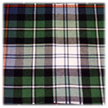
Dress MacKenzie – Ancient Colours
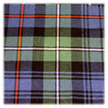
MacKenzie – Ancient Colours
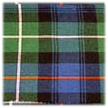
MacKenzie – Old Colours
Learn More About Mackenzie Tartans
Who Can Wear the Tartan?
If your name is Mackenzie or one of the Sept names then you are entitled to wear the Clan Mackenzie Tartan. Although there is no law preventing you from wearing whatever tartan you like, there are rules of the Scottish Clan System. The rules of the Scottish clan system (I quote): Excepting the “District”, “Caledonia” and “Jacobite” tartans, no one should wear a tartan to which he is not by name or descent entitled. To do so is foolish and ill-mannered, invites scorn, and is contrary to the whole principle of the clan system. Nor does one “select” tartans from this or that “line” of ancestors. The vital question is, “To which Clan do I belong?”
1. You “belong” to the clan of which you bear the name or sept name.
2. You have no real right to wear your mother’s tartan unless you have taken her name.
3. You cannot belong to several clans at once.
4. Adherents (cliathe) of non-clan names are, as followers, sometimes allowed to wear the tartan (usually a hunting set if any) and to become members of a clan society.
The MacKenzie Tartan - by James Scarlett, CMS Magazine 1995
It would be easy to dismiss the Mackenzie tartan as being simply a regimental pattern – it has also been known as “MacLeod and Seaforth” from MacLeod’s Highlanders (H.L.I.) and the Seaforth Highlanders – which has been adopted by civilians of the Clan that produced the Regiments, but there is usually more to tartan than appears on the surface and much interest can be derived from delving below it; there will be no harm in asking where the military tartan came from.
There is a body of evidence which strongly suggests that the original tartan of the Highland Independent Companies was a simple blue, black and green check to which each of the Company Commanders added coloured over-checks to distinguish his own Company. By 1733, this had been superseded by a tartan common to all the Companies, still a blue, black and green but now with a red line, edged with black centred on the blue, and some other colour on the green. We know that, later on, the Grenadier Company of the 42nd Regiment wore this tartan with the red line repeated on the green and that Lord Loudoun’s Highlanders used a yellow line on the green; we do not know what colour, if any, was used by those soldiers of the 43rd/42nd who were not Grenadiers, but my conclusion is that there was such an over-check and that it was probably black. According to General Stewart of Garth, who was a historian even if he did not always get things precisely right, the new Regimental tartan for the 43rd was arrived at by removing the distinguishing coloured lines from the tartans of the Companies and combining what remained; on the face of it, this would leave us with the plain basic design, but if we move on one stage and remove the red line from the common tartan, we are left with a pair of black lines which, if moved to the outside of each alternate blue square, gives us the Black Watch tartan as it is today. That is not the only way that the tartan could could have come about. There is a Grant tartan that was around late in the eighteenth century (though its actual age and origin are unknown) which has, in addition to red and yellow over-checks, a pair of black lines appear around the edge of the blue square. “Yer pays yer money and takes yer choice!” But there seem to be no very good grounds for the commonly held view that the Black Watch tartan is actually an old Campbell set, though perhaps it is descended from one.
To this base the later Highlands regiments, the Gordons and the two Mackenzie formations, the Seaforths and the H.L.I., again added coloured over-checks, yellow for the Gordons and red and white for the others; some who claim expertise in these matters, and I do not, say that the latter are the colours of the uniform jacket facings. That is one story. Another could easily be built upon the existence of a MacRae tartan, an extension of the familiar Hunting MacRae, which is, in essence, Mackenzie with blue and green reversed. If this, and not the shorter version, is the correct one, it is indubitably old (D. W. Stewart claims it as a relic of “The ’15”) and, bearing in mind the old affinity between the MacRaes and the Mackenzies, it might have inspired the red and white over-checks in the latter tartan; alternatively, if it is the short form that is the genuine one, the Mackenzie tartan could easily have inspired the longer version. The study of tartan is full of imponderables like this, and the best we can usually do is to arrive at the framework, it cannot be called a skeleton because there are precious few bones to be found, and then keep an eye open for discoveries that may confirm or modify it. Unsuspected relics do make their appearance from time to time; only a few years ago a length of late eighteenth century hard tartan plaiding in a previously unrecorded pattern was found in the roof of a house in Bexhill-on-Sea.
Many old tartans were consigned to oblivion when the Sobieski brothers, so called, published their Vestiarium Scoticum, which presented a collection of rather lack-lustre designs masquerading as genuine sixteenth century tartans; if there was a tartan that could be called “Mackenzie” before the military set, it may well have disappeared at this time.
In “The Sets of the Scottish Tartans”, D. C. Stewart posed a question of what such a tartan might have been but went no further towards answering it than to suppose that it would have been a red one. I would go a little beyond that and suggest Ross as a likely basis; there are broad territorial similarities between tartan patterns and the framework of the Ross tartan, shared with the MacRaes, covers a wide area.
Finally for the uninitiated, a word about colour. Tartans are on sale under three main headings, “Ancient”, “Reproduction” and, although the word is naturally not mentioned, “Modern”. Ancient colours, sometimes called “old” or “vegetable colours”, are the popular washed-out pastel shades. Reproduction, or “muted” tartans are based on a relic found in a peat bog; they use grey instead of blue, and brown instead of green. “Modern” tartans use the very dark, almost black greens and blues which, with the very strong red and white, make the Mackenzie tartan look as if it has a plain black background with a grid of light lines superimposed. The point about all this is that the actual patterns ancient, modern or reproduction, are all the same. In the days when the tartan was made by Wilsons’ (the well-known Bannockburn weavers) as “78th or Ross-shire Highlanders”, green was of medium strength and rather yellowish, and blue dark but distinct, producing a clear bold pattern that we do not get with any of the present day colours. And (I quote from the firm’s pattern book of 1819) “The White of the Officers’ plaids is always silk”.
-by James Scarlett
[Probably the leading authority on tartan, the late James Scarlett was an author, hand weaver and consultant, having devoted over thirty years to studying the subject of tartan and its traditions. He is the author of Tartans of Scotland, The Tartan Spotter’s Guide, The Tartans of the Scottish Clans, How to Weave Fine Cloth and Tartan The Highland Textile. He hand wove a reproduction of a 1745 plaid for the National Trust of Scotland’s Culloden Battlefield Centre.]
The Mystery Tartan
The Mackenzies possessed the largest single area of land in Scotland in their day and therefore if there was a regional tartan for Kintail & Mid-Ross then it could have been worn quite often by Mackenzie Clansmen and Septs of the Clan.
There are suggestions that there was an earlier Mackenzie tartan worn before 1700 and that this has since been lost and replaced by the military version. Apparently the pattern was predominantly Red. It is also interesting to note that the tartans for the Clans MacRae, Matheson and Ross (all associated with Ross-shire) are, with individual differences, all predominantly red with green and black stripes!
There have been very close associations between the Mackenzies and the clans MacRae, Matheson and Ross, especially in the early days; could there be a relationship here and could the original tartan for the Mackenzies have been something similar being predominantly red with green and perhaps black stripes? Could they be variations of an earlier Ross-shire district tartan? Perhaps this is why the present day Mackenzie tartan has those Red and Black Stripes? In many cases the white stripe denoted an officer and was originally made of silk.
